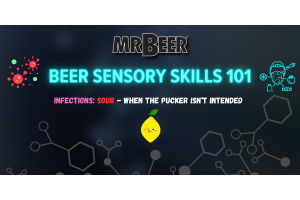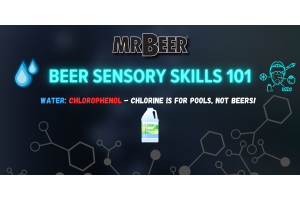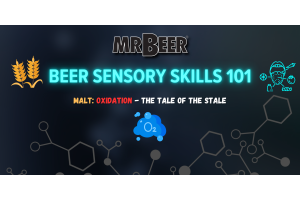How to Arrange Beers for a Buzzworthy Tasting

Creating a particular order for the beers you and your friends are tasting may seem like too much fuss, but it can most definitely have an effect on the impression you get from each beer. If you line them up wrong you could have everyone hating a beer that is actually delicious, simply because it mixed with flavors still on their tongue from the last glass.
This used to happen to me whenever a brewery or brewpub handed out a flight with no care taken for organization. I'd sip a Barrel-aged Stout, then a Lime Gose, then a Double Red Ale, then a crisp Saison and by the end I'm just thinking, "Ew, my tongue tastes like grapefruit and stale bread. I need water."
Do you remember what your mouth tastes like when you brush your teeth after a tall glass of orange juice? Did you just cringe? Yep, that much can go wrong when two disparate beers are tasted back to back. No joke. Time to for you to learn the important life skill of arranging your beers so that you stop grossing people out.
Steps to Beer Tasting Greatness
Every week I arrange beers for our office's Thirsty Thursday tasting, and though I've been doing it for 6 months – I still have to get a second opinion sometimes because beer is shifty. So don't get discouraged if you taste that you could've done better in the middle of a tasting – there is still beer, and people are drinking it, so life is good.
1. Figure out the ABV, IBU, Beer Style
I always start with these bits of information when arranging beers. Unfortunately, there are still many brewery sites that do not list all of these details, and that's when I snoop BeerAdvocate, Untappd, or just good ol' Google.
Why ABV?
Beers with a higher percentage of alcohol by volume are likely to be warming on the tongue. Some are so high that they can make your tongue feel numb (which is actually why Mr. Beer named their 10.7% ABV Barleywine "Novacaine"). All that tingle is better meant for the end of the tasting. You don't want to numb your tongue up right at the beginning, and lose out on the flavor in beers that follow. And think about it, Sessions (named for their lower ABV and easy drinkability) are often lighter in flavor, and will stand out better toward the beginning of the tasting.
Why IBU?
When IBU, or International Bitterness Units, are especially high they can leave a lingering flavor on the tongue. Many bold IPAs will have 100+ IBU, and though there is certainly nothing wrong with that, it's likely that all that bitterness will affect the beer you drink next. If you choose to drink more than one high IBU beer in one tasting, you run the risk of not being able to taste any real detail in the beer that hits your tongue after that initial hit of hoppy bitterness.
Why Beer Style?
This parameter is less relevant than the others, but when information is slim it's sometimes all you've got to run with. I say it's less relevant because brewers are venturing out more. Just because a brewery labels a beer as a Stout, doesn't mean it will be on style. We've had Stouts that were so fluffy and light they were more like a bold Amber Ale. Though it seems simple to assume that "according to style these beers will have a balanced flavor of biscuit malts and citrus hops, so they'll be great before we sip this hoppier ale style" – you never know! One of those "balanced" beers may instead have a punch of hop bitterness at the end that even makes the "hoppier" style look weak. While you make choose to place all beers of a certain style beside each other in a tasting, they may not be as similar as you'd think.
2. Try to read as many additional notes as possible
There will be times when several beers in your tasting will be of the same style with same/similar ABV and IBU. The tie-breaker will be in the details. Maybe you have two similar IPAs, but one has a bazillion different hops in it while the other has only two. Choose the beer with less "going on" to taste first. In this case that'd be the two-hopped one. Maybe between two, one has reviews online claiming that it is very spicy, while the other is listed as having a pleasing, crisp bitterness. Place the spicier one after the crisp one.
The Take Aways:
- Order your beers mellow to more bold
- Do not place too many bold beers back-to-back
Example: An Ale Tasting
Currently our work fridge is full of some serious medal winning beers with high IBU and similar ABV. I couldn't place them all in the same tasting because all of that bitterness would wreck palates. I also knew that running through stellar beer had to be a sin of some sort. So, my colleagues and I ran off to find some other flavorful ales to round out our tasting. Since there seem to be so many new New Belgium brews at our local beer shop we found two with lower IBU and ABV, but promising flavor. Here's what our tasting looked like:
New Belgium - Dayblazer Easygoing Ale
ABV 4.8% // IBU 13
New Belgium – Citradelic Exotic Lime Ale
ABV 5.2% // IBU 21
Cumbre – Elevated IPA – GABF Gold Medal Winner 2011, World Beer Cup Bronze Medal Winner 2012
ABV 7.2% // IBU 100
Red Glove – Double Red Ale – GABF Gold Medal Winner 2016
ABV 7.2% // IBU 100





